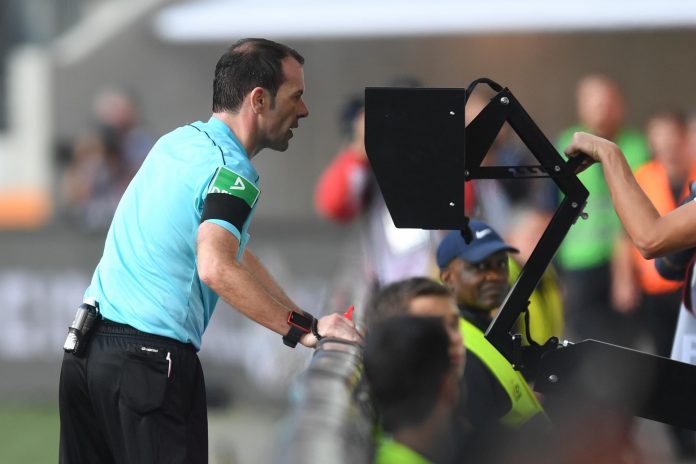This summer, virtual assistant referees (VARs) will be used in the 2018 World Cup Russia. The decision came after football’s lawmakers met up to vote. In a unanimous decision, they voted in favor of the technology being implemented. So far, public opinion is divided. Either way, VARs will have an impact on the game as it has on many other sports, including poker, for better or worse.
The decision was made during a meeting of the International Football Association Board on March 2nd, following several years of trials of the technology in 972 matches, across 20+ leagues. Four representatives from FIFA, as well as a representative from each of the home nations, made the call, which has been described as a “historic step for greater fairness in football.”
As well as the World Cup, which, unfortunately, Turkey didn’t qualify for, the virtual assistant referee technology will also feature in the 2018 FA Cup, as well as in major leagues like the German Bundesliga. So far, it is looking uncertain as to whether the tech will make an appearance in the Premier League.
The delays to the games caused by the VARs in Russia may frustrate fans, but FIFA will have the opportunity to use these broadcasting segments for branding and sponsorship, providing yet another stream of advertising revenue.
-
How do VARs work?
VARs work with a three-step process of incident, review and decision. The system is designed to correct clear errors and missed incidents in “match changing situations.” The philosophy is to provide the most benefit to the fairness of the game with minimal disruption.
VARs are old or existing referees who have access to more information, replays and camera angles. The VARs or the assistant referees can recommend a review of a severe or missed incident, or the referee can call for a VARs review by making the on-pitch signal. The refs can even review the incident themselves using a pitch-side monitor.
Once the incident has been reviewed, the referees’ still makes the final decision — whether to stick with was said or overrule their previous decision based on the VARs.
As it stands, the VARs can be used to:
- Check the validity of goals and whether an infringement disallows them.
- Make a correct decision over a penalty.
- Check over red card rulings, and in cases of mistaken identity.
- Make sure the correct players are penalized and innocent players are not punished.
-
Will VARs benefit the game?
There are arguments for and against the use of VARs. For starters, concerns have been voiced on the flow of the match. The virtual assistant referee process takes time and can reduce the overall movement and excitement of the game — arguably, a big blow for the spectator. The average time for a review is around 55 seconds.
Proponents of the technology argue that overall time is saved, as free kick time wasted is around 8 minutes 15 seconds. The VARs should, in theory, reduce the number of incidents, improving the overall flow of the game. In theory.
Now, the VARs can only be used in specific scenarios that are considered critical. The refs can’t even consult the reviews for a yellow card. However, the flow of the game could be disrupted if the VARs become the norm for all or most decisions.
There are concerns over the confusion and chaos the VARs system may cause players and fans. Decisions overrules and long pauses for reviews — it all creates uncertainty and tension. However, this can be improved with better communication. For example, plans are underway to show the VARs reviews and give information about what is happening and why over the big screens in stadiums.
Some people think that the referees will be undervalued and undermined with the use of VARs. Again, this could be a problem without proper regulation, but as it stands now, it is the referees who make the choice to review a decision, and they are still the only ones who can make the final decision.
It is believed by those in charge at least that any criticisms and concerns will be worth it when the benefits are considered. Making the right decisions has to be a priority for any referee, and the VARs will inevitably lead to more accurate decisions, meaning fairer games and outcomes. Players will also be less able to “get away with it,” and over time, incidences should reduce. No more “Hand of God” by Maradona!
-
Technology in Football and Other Sports
Technology is a part of life, so it was always going to creep into even the most traditional sports. Referees were assisted for the first time in the 2014 World Cup Brazil in the form of goal-line technology. Goal-line technology sends an instant message to the ref’s watch, stating whether the ball crossed over the line, and has an accuracy of millimeters.
There are several systems of goal-line technology, such as the Hawk-Eye System used in the Premier League, as well as in tennis, cricket and rugby. Cameras take footage at 600 frames per second to provide decisions within seconds.
In the same year, foam technology was introduced at the World Cup. Though it may seem simple, a sprayable foam made from water and butane allowed refs to mark the spot from which teams should take their free kick. The spray then fully evaporates after about a minute. Fancy Texas Hold ‘Em?
In online poker, HUDs allow players to capture, record and view information about their opponents. This way, statistics can be collected, giving players who use the technology more of an edge. Statistics and technologies like this contributed significantly to the poker boom.
In addition to poker, the viewer experience has also been greatly improved by technology in recent years. Digital enhancements show audiences lines such as in cricket. For example, where the ball was bowled and where it hit the stumps. In rugby, it can show where the line should be for a free kick taker.

Source: Stats
Televised poker competitions show the hole cards revealed on camera while on-screen percentages show which hands are most likely to win during the hand. The stats automatically update as the poker hand progresses, giving fans more excitement and understanding of the game.
If you think about it, the “third umpire” in cricket, who helps to make decisions using TV monitors and replays, is not much different from the virtual assistant referee in football. Though VARs will be a part of the World Cup in Russia this year, time will tell whether they will improve the game for players and fans. Starting in 2026, the number of teams in the World Cup will increase from 32 to 48, giving teams like Turkey a better shot of qualification, which could mean a significant impact on the part of VARs.











